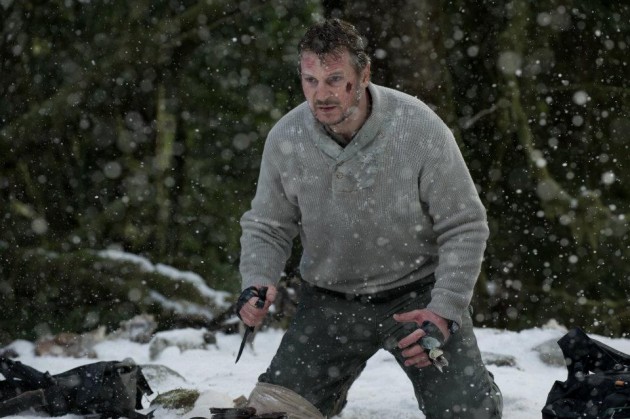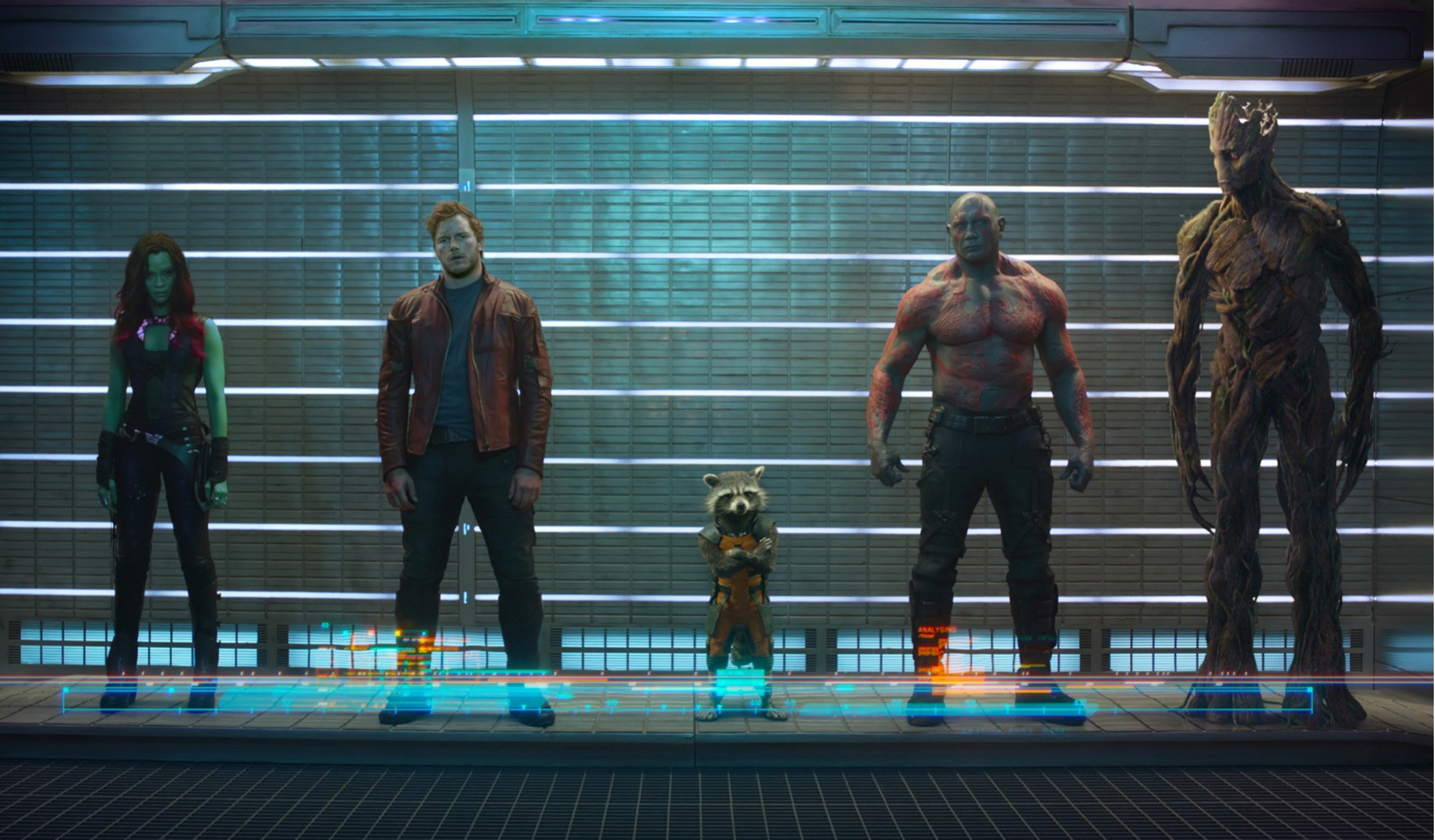 ho would have thought that the hardest movie I ever had to review was one of the most insignificant movies I’ve ever seen? Here’s my difficulty: Carrie 2013 is a terrible movie. But I really liked it a lot. So this review will be conflicted and incoherent.
ho would have thought that the hardest movie I ever had to review was one of the most insignificant movies I’ve ever seen? Here’s my difficulty: Carrie 2013 is a terrible movie. But I really liked it a lot. So this review will be conflicted and incoherent.
Carrie 2013 is an entirely unnecessary update of one of a handful of films that can be called pretty close to perfect (overlooking for now the inherent flaws in Stephen King’s misanthropist, self-loathing sociopathy). The word “iconic” is much overused. But in the case of Brian DePalma’s 1976 masterpiece, it’s fully justified.
So why, Kimberly Peirce, after making your reputation with a couple of heartfelt—even heartbreaking—small scale character dramas (Boys Don”t Cry, Stop-Loss), did you decide for your third feature to copy a film that’s so close to perfect that any reworking you give it can only be a step down? It”s possible Peirce understood this: her version kowtows to DePalma’s in almost every way. It’s practically a shot for shot duplicate. Perhaps it would have been better if she had molded it to fit an aesthetic she seems to be more comfortable with: a small-scale indie drama. There are enough parallels between Carrie and Brandon Teena, the trans boy and subject of Boys Don”t Cry, whose life was made miserable—and then tragically brief—by, essentially, bullies writ monstrous—that I think that that Carrie would be an interesting movie to see. But instead, in trying to remain respectful to DePalma, Peirce limits her own ability to make the material something that might have resonated more with her as an artist.
 Still, by turning all her knobs to 11, Peirce kind of manages to give the audience a groaningly fun ride. Details are updated for the current bullying fad, with cellphone videos and youtube upping the ante, and the update is rife with clear references to the post-Columbine era. Peirce”s gooey, gorey emphasis on King’s ridiculous throughline from menstrual blood to Christ’s blood to pig’s blood gives the whole thing a kind of grand guignol camp that makes it impossible not to laugh at. So, although ultimately I feel dirty for saying so, I enjoyed Carrie 2013. It was a bit like making your way through a community theater troupe’s Halloween haunted house, laughing and screaming in roughly equal measure.
Still, by turning all her knobs to 11, Peirce kind of manages to give the audience a groaningly fun ride. Details are updated for the current bullying fad, with cellphone videos and youtube upping the ante, and the update is rife with clear references to the post-Columbine era. Peirce”s gooey, gorey emphasis on King’s ridiculous throughline from menstrual blood to Christ’s blood to pig’s blood gives the whole thing a kind of grand guignol camp that makes it impossible not to laugh at. So, although ultimately I feel dirty for saying so, I enjoyed Carrie 2013. It was a bit like making your way through a community theater troupe’s Halloween haunted house, laughing and screaming in roughly equal measure.

My ambivalence toward this film made it very difficult for me to construct any kind of coherent narrative, so the rest of this “review” will be in the form of notes; random thoughts generated by contemplation of Carrie 2013.
- When a play is revived on the stage, there’s generally a worshipful respect for the script. The writing is the thing. But when a movie is remade, that would seem weird. It’s expected for a movie remake to take an entirely new approach to the material. Perhaps this is because a film is recorded, and you can “revive” it any time you want, while a performed play’s ephemeral nature makes recapturing the entire fleeting experience more of a priority. Also, when a movie gets remade, an additional layer is added: whatever the original story was, fate is now a larger component. The ending is familiar; inevitable: it lends to every remake a vaguely Greek element.
- The opening of Carrie 2013 puts into perspective one of the things that always bothered me about Harry Potter. After the animated logos are all done, we hear from the black screen a bloodcurdling scream. It sounds like a child being tortured. The camera zooms slowly in on a door. It’s a closet under the stairs. And then—PSYCH!—the camera tracks past the door and up the stairs, and we discover that the screamer is a woman undergoing a gory labor. But hang on . . . what we just recognized instantly, viscerally, as a sign of the worst possible child abuse—a closet under the stairs!—we accept as merely eccentric, even cute and cozy, in Harry Potter. I always felt Rowling kind of minimized the horror of that situation. Surely our reaction to Carrie’s closet is more realistic?Thus Carrie 2013 begins with one of the only deviations from DePalma: Mrs. White giving birth to Carrie, completely unaware that she had even been impregnated when her husband raped her on his way out of town. When the freshly expelled bloody lump of what she had believed to be cancer begins to howl, suddenly there appear in her hand a pair of Movie Scissors, those huge shears that no one has ever seen in real life but that always seem to be on hand when someone in a movie—usually a woman, if the weapon is scissors—gets especially stabby. Ultimately, as she later tells Carrie, she was “weak” and allowed the child to live. Also, the sheets were pretty much a write off. So begins a film-long meditation on Blood as a Religious Symbol.
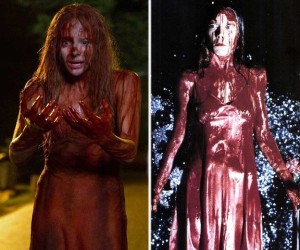 On Chloë Grace Moretz versus Sissy Spacek as Carrie. Carrie 2013’s biggest flaw is the casting of Moretz. She’s a good actor, but she’s just too cherubic to play the pathetic outsider. If someone who looked and sounded like Chloe was the high school’s outcast, there would have to be something truly wrong with her. She’s genetically predisposed to be popular, so any shunning would have to come from her behavior. Sissy Spacek, though far from ugly, was just bony and haunted enough to inhabit the character completely. Added to that her stringy straight hair in the Farrah era and her white-rat unmascaraed lashes, and you don’t have any problem at all picturing her sitting alone at lunchtime. Moretz’s Carrie hasn’t learned the first thing a bullying victim learns: BLEND. Spacek carries herself closed in, but she walks quickly through the hallways, not making eye contact, glancing aside like a hunted animal. Moretz hunches along, her head hanging between her shoulders like a cartoon vulture’s, looking at the floor when she isn’t giving people pleading “don’t hit me!” glances. She wears an invisible but inviting “kick me” sign on her back and on her forehead. She makes herself more of a target, rather than fading into the woodwork like Spacek’s Carrie.
On Chloë Grace Moretz versus Sissy Spacek as Carrie. Carrie 2013’s biggest flaw is the casting of Moretz. She’s a good actor, but she’s just too cherubic to play the pathetic outsider. If someone who looked and sounded like Chloe was the high school’s outcast, there would have to be something truly wrong with her. She’s genetically predisposed to be popular, so any shunning would have to come from her behavior. Sissy Spacek, though far from ugly, was just bony and haunted enough to inhabit the character completely. Added to that her stringy straight hair in the Farrah era and her white-rat unmascaraed lashes, and you don’t have any problem at all picturing her sitting alone at lunchtime. Moretz’s Carrie hasn’t learned the first thing a bullying victim learns: BLEND. Spacek carries herself closed in, but she walks quickly through the hallways, not making eye contact, glancing aside like a hunted animal. Moretz hunches along, her head hanging between her shoulders like a cartoon vulture’s, looking at the floor when she isn’t giving people pleading “don’t hit me!” glances. She wears an invisible but inviting “kick me” sign on her back and on her forehead. She makes herself more of a target, rather than fading into the woodwork like Spacek’s Carrie.
- After the disco ball blood bath (Hello Chicago! We’re DiscoBallBloodBath! Thanks for comin out!), when Carrie unleashes her rage, Spacek played it like the dam had broken on a lifetime of withheld casino anger, and rage just broadcast from her in waves. Moretz plays it like Harry Potter might: she conducts the mayhem with her hands—pointing, lifting, pushing, aiming. It’s too specific, which makes it smaller. I half expected her to twinkle-dinkle-dink her nose like Samantha Stevens.
- Michael Medved, a hard-right ostensible Christian and self-styled moral arbiter, was at the screening I attended. His presence inserted itself as kind of a constant filter in my mind as I watched the movie; so much of the motivation of the main characters is presented in terms of religion. Carrie’s mother, as portrayed by Julianne Moore, is insane with a mania that begins and ends with fundamentalist christianity. Her every waking moment is consumed with her fear of a vengeful god. Rather than mortify herself with a flail, or with stones in her shoes like the reluctant saint of Wise Blood, she scratches at spiritual mosquito bites on her arms till they look like something out of BODIES The Exhibition, and stabs herself in the thigh with sewing implements while she carries on a relatively innocuous retail conversation at her job.
- King’s original novel—his first, and thus the only one he spent years writing and didn’t just dash off in a week or two—is epistolary in nature: no third-person-omniscient narrator, but a collection of newspaper clippings, letters, etc., patching together a story from the bits and pieces of others’ observations. I’m not sure if DePalma had this in mind when he chose to shoot his version in such a disorienting mashup of styles, even going so far as to split the screen into simultaneous narratives at the film”s climax, but it’s part of the film’s power. Peirce dials that back a bit. She frames most of the shots exactly as DePalma did. She uses less slomo, but when she does it”s for shots where DePalma had previously used it. But for the most part Carrie 2013 is stylistically more like 10 Things I Hate About You meets Scream 1-4.
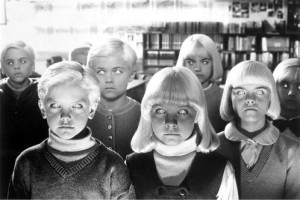 What would movie proms look like without the original Carrie’s iconography? Since Carrie, every movie-high-school prom carries a kind of dread—we just know it’s going to end horribly. Carrie weighted the prom with a sense of danger and vengeance for all time, the way Village of the Damned made children the scariest things in horror movies.
What would movie proms look like without the original Carrie’s iconography? Since Carrie, every movie-high-school prom carries a kind of dread—we just know it’s going to end horribly. Carrie weighted the prom with a sense of danger and vengeance for all time, the way Village of the Damned made children the scariest things in horror movies.
- Carrie is ultimately a “blame the victim” story, thanks to King’s twisted worldview. The money shot is Carrie”s pig’s blood shower: at that moment, we’re all voyeurs to her pain. It’s a high-production-value youtube bullying video. But we get to have it both ways: we get to be secretly entertained by witnessing the weird kid’s torture, and then we get to switch sides once she’s no longer powerless. And in the end, of course, the bullies are justified: they picked on Carrie because she was “a freak,” and we fear what we don’t understand. Turns out she’s a HUGE freak, and everyone was completely right to fear her.
- King”s novel ends—spoiler!—with the White house destroyed by a hail of stones, burying Carrie and her mother. DePalma didn”t like the special effects for that ending, so he changed it to have the house kind of fall in on itself. With present-day CGI capabilities, Carrie 2013 returns to the original ending. Stones falling from the sky has a distinctly biblical flavor, which renders the ending a little more ambiguous: was the storm of stones caused by Carrie”s rage? Or the wrath of God? If the former, cool, whatever, you go girl. But if it”s the latter, then Carrie”s mother, in her religious hysteria, was right all along, and Carrie”s powers carried the sin of witchcraft, so God smote her. I wonder if that made it a more satisfying ending for Mr. Medved?

So do I recommend it? With reservations. I can see Carrie 2013 becoming a perennial Halloween classic; it”s “Halloweeny” in that it wears its artificiality on its sleeve. It”s dress up and make believe. (Moretz”s fake blood is very clearly painted on, a sacrifice of reality to continuity. But Spacek took that sacrifice on herself in 1976: she simply didn”t wash the blood off for three days, sleeping in the bloody prom dress for continuity”s sake.) So if you get dragged along, enjoy it the way most people enjoy “bad” movies. But if you want a defining, yes iconic movie experience, see DePalma”s 1976 version instead.

Carrie
Opens everywhere October 18, 2013
Running time 1:39
Rated R
Director: Kimberly Peirce
Writers: Lawrence D. Cohen and Roberto Aguirre-Sacasa
Original novel: Stephen King
Metro-Goldwyn-Mayer Pictures and Screen Gems
Chloë Grace Moretz
Julianne Moore
Judy Greer
Ansel Elgort

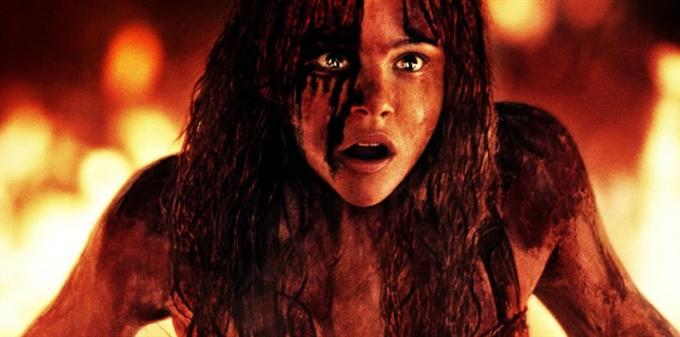
![Best Show on Netflix? "Top of the Lake" [Streamers]](https://drunksunshine.com/wp-content/uploads/2013/06/1362729750825.jpg)
